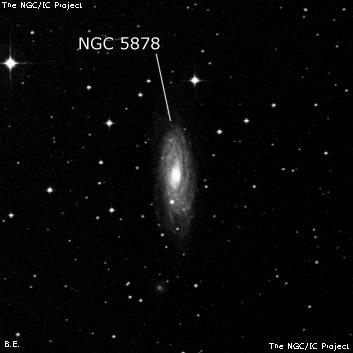
William Herschel discovered NGC 5878 = H III-736 = h3593 on 30 Apr 1788 (sweep 839) and recorded "vF; lbM; pL; E in the meridian; 300 showed the same." John Herschel made the single observation "B; pmE; psmbM; involves a * 14m to northward." His comment probably refer to the faint star on the south side. Using the 48-inch Melbourne Telescope on 21 May 1878, Joseph Turner felt the faint star at the south end was not "involved" but just east of the south tip. Although slightly east of the major axis, it is superimposed on the edge of the halo (p.179 of logbook).
200/250mm - 8" (4/24/82): fairly faint, elongated N-S. A mag 7 star is in the field to the east.
300/350mm - 13.1" (5/26/84): fairly bright, fairly small, elongated 2:1 N-S, small bright nucleus, much fainter extensions. A mag 15 star is at the SSE edge 0.9' from center. Forms a pair with MCG -02-39-009 8' SE. Located 8.8' SW of mag 7.0 SAO 159117.
400/500mm - 18" (6/13/07): in poor seeing appeared fairly bright, moderately large, very elongated 3:1 N-S, ~1.5'x0.5', sharply concentrated with a bright, round core that increases to a quasi-stellar nucleus. Located 9' SW of an orange mag 7 star (HD 135207). MCG -02-39-009 lies 8' SE.
Notes by Steve Gottlieb